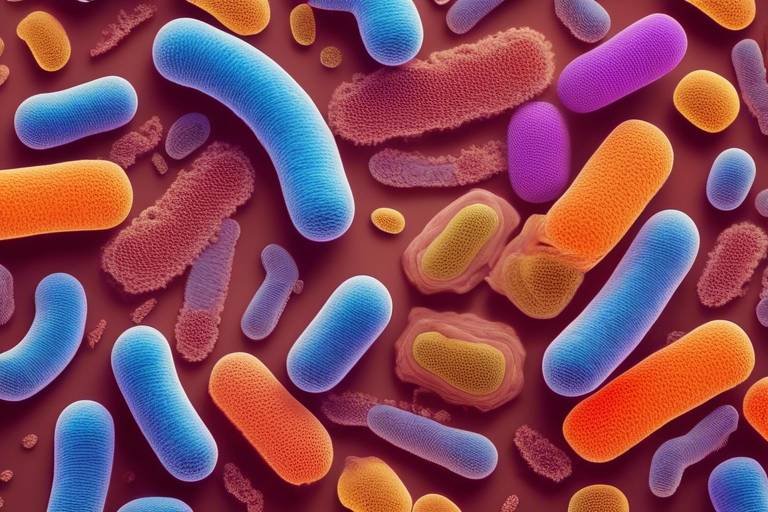The Chemistry of Fermented Foods - Probiotic Power
Have you ever wondered why fermented foods have become a staple in health-conscious diets around the world? The magic lies in the chemistry behind them! Fermented foods, such as yogurt, kimchi, and sauerkraut, are not just tasty; they are powerhouses of probiotics that can transform your gut health. This article dives deep into the fascinating world of fermentation, exploring the biochemical processes that make these foods so beneficial and the impact they have on our overall well-being.
At its core, fermentation is a natural process where microorganisms like bacteria, yeast, and molds break down sugars and starches into acids, gases, or alcohol. Think of it as a culinary alchemy, where simple ingredients are transformed into something extraordinary. The result? Foods that are not only delicious but also packed with health benefits.
But why should you care about these tiny microbes? Well, probiotics, which are the beneficial bacteria found in fermented foods, play a crucial role in maintaining a healthy gut microbiome. They help balance the good and bad bacteria in your digestive system, leading to improved digestion and enhanced immunity. So, the next time you enjoy a bowl of yogurt or a serving of kimchi, remember that you are not just indulging in a tasty treat; you are also feeding your body with essential probiotic power.
In this article, we will uncover the secrets of the fermentation process, discuss the myriad health benefits of probiotics, and explore various fermented foods from around the globe. We will also take a closer look at the role of lactic acid bacteria, the different types that contribute to flavor and preservation, and how fermentation can enhance the nutritional value of foods. So, buckle up as we embark on this delicious journey through the chemistry of fermented foods!

The Fermentation Process
Understanding the fermentation process is crucial to appreciating how fermented foods are made. At its core, fermentation is a biochemical transformation that occurs when microorganisms like bacteria, yeasts, or molds convert sugars into acids, gases, or alcohol. This process not only preserves food but also enhances its flavor and nutritional value. Imagine a tiny world bustling with activity, where these microorganisms are the unsung heroes, working tirelessly to transform simple ingredients into something extraordinary.
The journey of fermentation begins when the right conditions are met. Typically, this involves a source of sugar, a suitable temperature, and the presence of microorganisms. For instance, in the case of yogurt, milk is heated and then cooled to a temperature that is conducive for the addition of specific lactic acid bacteria. These bacteria then consume the lactose (the sugar in milk) and produce lactic acid as a byproduct. This acid not only gives yogurt its tangy flavor but also acts as a natural preservative, inhibiting the growth of harmful bacteria.
But what exactly happens during fermentation? The process can be broken down into a few key stages:
- Inoculation: This is when the microorganisms are introduced to the food source. In our yogurt example, this is when the starter culture is added to the milk.
- Fermentation: This stage involves the active conversion of sugars by the microorganisms. The duration can vary from a few hours to several days, depending on the food being fermented.
- Ripening: Some fermented products undergo a ripening phase, where flavors and textures continue to develop. This is common in cheeses.
The significance of fermentation extends beyond just preservation. It plays a vital role in food production, contributing to the unique characteristics of various fermented foods. For example, the fermentation of cabbage into sauerkraut not only enhances its shelf life but also transforms its flavor profile from raw and crunchy to tangy and complex. This transformation is a result of the intricate dance of microorganisms, producing a range of compounds that tantalize our taste buds.
Furthermore, the fermentation process can vary widely depending on the type of food and the microorganisms involved. Different strains of bacteria or yeast can lead to diverse flavors, textures, and aromas. For instance, the fermentation of soybeans into miso involves a different set of microorganisms than those used in the fermentation of grapes into wine. Each method brings its own unique twist to the final product, showcasing the incredible versatility of fermentation.
In summary, the fermentation process is a fascinating interplay of science and art. It transforms ordinary ingredients into extraordinary foods, enriching our diets and cultures. As we delve deeper into the world of fermented foods, we begin to appreciate not just their flavors, but the complex chemistry that makes them possible. So, the next time you enjoy a bite of kimchi or sip on kombucha, remember the tiny warriors behind the scenes, working their magic to create these delicious and healthful treats.
Here are some common questions about the fermentation process:
- What types of foods can be fermented? Almost any food can be fermented, including vegetables, fruits, dairy, and even grains.
- How long does fermentation take? The duration varies widely depending on the food and the desired flavor profile, ranging from hours to several months.
- Is fermentation safe? Yes, when done correctly, fermentation is a safe and healthy method of food preservation.

Health Benefits of Probiotics
When it comes to our health, we often think about the food we eat and the exercise we do. But have you ever considered the tiny organisms living in your gut? Yes, we're talking about probiotics! These friendly bacteria are more than just a trendy health buzzword; they play a crucial role in maintaining our overall well-being. Probiotics are known to enhance gut health, which is the foundation of our immune system and overall health. But how exactly do they work their magic?
Probiotics help balance the gut microbiome, a complex community of microorganisms that live in our intestines. When this balance is disrupted—due to factors like poor diet, stress, or antibiotics—it can lead to digestive issues and other health problems. By consuming probiotic-rich foods or supplements, we can replenish these beneficial bacteria. This leads to a plethora of health benefits, including:
- Improved Digestion: Probiotics aid in breaking down food, making it easier for your body to absorb nutrients. They can also help alleviate common digestive issues like bloating, gas, and constipation.
- Enhanced Immunity: A healthy gut is vital for a strong immune system. Probiotics can enhance the production of antibodies and promote the activity of immune cells, helping your body fend off infections.
- Mental Health Benefits: Surprisingly, your gut health can impact your mental well-being. Research suggests that a healthy gut microbiome can help reduce symptoms of anxiety and depression, thanks to the gut-brain connection.
Moreover, probiotics can play a role in preventing certain diseases. Studies have shown that they may reduce the risk of conditions such as irritable bowel syndrome (IBS), inflammatory bowel disease (IBD), and even some allergies. It's fascinating to think that by nurturing our gut flora, we can potentially ward off these ailments!
But not all probiotics are created equal. Different strains offer different benefits. For instance, Lactobacillus rhamnosus is known for its digestive health benefits, while Bifidobacterium longum is often linked to immune support. This diversity is what makes probiotics so exciting; they can be tailored to meet specific health needs.
Incorporating probiotics into your diet can be as simple as enjoying a serving of yogurt, kefir, sauerkraut, or kimchi. These foods are not only delicious but also packed with live cultures that can boost your gut health. If you're not a fan of fermented foods, consider a high-quality probiotic supplement to help you reap the benefits.
In conclusion, the health benefits of probiotics are vast and varied. From enhancing digestion to supporting mental health, these tiny organisms have a big impact on our overall well-being. So, the next time you're enjoying a tangy yogurt or a crunchy pickle, remember that you're not just savoring a tasty treat; you're also fueling your body with powerful probiotics!
Q: How do I know if I need probiotics?
A: If you experience digestive issues, have recently taken antibiotics, or want to improve your overall gut health, probiotics may be beneficial.
Q: Can I get enough probiotics from food alone?
A: While many fermented foods are rich in probiotics, some individuals may benefit from supplements, especially if they have specific health concerns.
Q: Are there any side effects of taking probiotics?
A: Generally, probiotics are safe for most people. However, some may experience mild digestive upset initially. It's always best to consult with a healthcare professional before starting any new supplement.

The Role of Lactic Acid Bacteria
Lactic acid bacteria (LAB) are the unsung heroes of the fermentation world. These tiny microorganisms are not just responsible for transforming our food; they also play a crucial role in enhancing our health. Found in a variety of fermented foods, such as yogurt, sauerkraut, and kimchi, LAB work tirelessly to convert sugars into lactic acid through a process known as fermentation. This transformation not only preserves the food but also gives it that distinctive tangy flavor we all love.
But what exactly do these bacteria do? First and foremost, they create an environment that inhibits the growth of harmful bacteria, essentially acting as natural preservatives. By lowering the pH of the food, LAB help to ensure that the final product is safe for consumption and has a longer shelf life. This natural preservation method is one of the reasons why fermented foods have been staples in diets around the world for centuries.
Moreover, LAB are champions of gut health. When we consume fermented foods rich in these bacteria, we are essentially introducing beneficial probiotics into our digestive systems. These probiotics help balance the gut microbiota, which is crucial for maintaining overall health. A healthy gut can lead to improved digestion, enhanced immunity, and even positive effects on mental health. It's like having a personal army of tiny soldiers fighting off the bad guys in your gut!
Interestingly, different strains of lactic acid bacteria offer varying benefits. Some strains are particularly effective at breaking down lactose, making them a godsend for those who are lactose intolerant. Others may produce specific vitamins or compounds that further enhance health benefits. For instance, certain LAB strains can synthesize B vitamins, which are essential for energy metabolism.
Here’s a quick look at some of the most common types of lactic acid bacteria and their unique contributions:
| Type of Lactic Acid Bacteria | Common Sources | Health Benefits |
|---|---|---|
| Lactobacillus | Yogurt, kefir | Improves lactose digestion, boosts immune function |
| Streptococcus | Cheese | Enhances flavor, aids in digestion |
| Leuconostoc | Sauerkraut, pickles | Supports gut health, enhances nutrient absorption |
In summary, lactic acid bacteria are more than just fermenters; they are vital players in the realm of nutrition and health. By understanding their role and incorporating fermented foods into our diets, we can harness their probiotic power to promote a healthier lifestyle. So, the next time you enjoy a bowl of yogurt or a tangy pickle, remember that you’re not just indulging in a tasty treat; you’re also giving your gut a boost!
- What are lactic acid bacteria? Lactic acid bacteria are a group of beneficial microorganisms that ferment sugars into lactic acid, playing a crucial role in the production of various fermented foods.
- How do lactic acid bacteria benefit health? They help maintain gut health, improve digestion, boost immunity, and may even have positive effects on mental health.
- Where can I find lactic acid bacteria? LAB are commonly found in fermented foods such as yogurt, kefir, sauerkraut, kimchi, and various types of cheese.
- Can I get enough probiotics from fermented foods? Yes, consuming a variety of fermented foods can provide a good source of probiotics, contributing to a balanced gut microbiome.

Types of Lactic Acid Bacteria
Lactic acid bacteria (LAB) are a diverse group of microorganisms that play a pivotal role in the fermentation process, transforming ordinary ingredients into extraordinary foods. These tiny powerhouses are not just responsible for the tangy flavors in yogurt and sauerkraut; they also contribute to the preservation and health benefits of these foods. Understanding the different types of lactic acid bacteria can help us appreciate their unique contributions to our diets and overall health.
Among the most well-known types of lactic acid bacteria are Lactobacillus, Streptococcus, and Leuconostoc. Each of these genera contains various species, each with its own characteristics and roles in fermentation:
| Type of Lactic Acid Bacteria | Common Species | Typical Uses |
|---|---|---|
| Lactobacillus | Lactobacillus acidophilus, Lactobacillus bulgaricus | Yogurt, kefir, and fermented dairy products |
| Streptococcus | Streptococcus thermophilus | Yogurt and cheese production |
| Leuconostoc | Leuconostoc mesenteroides | Fermented vegetables, such as sauerkraut and pickles |
Each of these bacteria not only helps in the fermentation process but also brings its own unique flavor profile and health benefits. For instance, Lactobacillus acidophilus is well-known for its ability to survive stomach acid, making it a popular probiotic strain that supports gut health. On the other hand, Streptococcus thermophilus is essential for yogurt production, where it works in synergy with other bacteria to create that creamy texture and tangy taste.
Another interesting aspect is the role of Leuconostoc species in vegetable fermentation. These bacteria are crucial for the initial stages of fermenting vegetables, producing carbon dioxide, which helps create an anaerobic environment that prevents spoilage. This process not only preserves the vegetables but also enhances their flavor and nutritional value, making them a staple in many cultures around the world.
As we delve deeper into the world of lactic acid bacteria, it's fascinating to note that some strains are more effective in certain environments than others. For example, Lactobacillus plantarum thrives in fermented plant-based foods, while Enterococcus species are often found in dairy products. Understanding these preferences allows food producers to tailor their fermentation processes to achieve the desired taste and health outcomes.
In summary, the types of lactic acid bacteria are as varied as the foods they help create. From the tangy yogurt on your breakfast table to the crunchy pickles at your barbecue, these microorganisms are essential in transforming our food and enhancing our health. So, the next time you enjoy a delicious fermented food, take a moment to appreciate the tiny bacteria that made it possible!
- What are lactic acid bacteria? Lactic acid bacteria are a group of microorganisms that ferment sugars to produce lactic acid, which helps preserve food and enhance its flavor.
- How do lactic acid bacteria benefit health? They support gut health, improve digestion, and may boost the immune system, among other benefits.
- Can I get lactic acid bacteria from foods? Yes, fermented foods like yogurt, kefir, sauerkraut, and kimchi are rich sources of lactic acid bacteria.

Fermentation and Flavor Development
When we think about our favorite foods, flavor is often at the forefront of our minds. But have you ever considered the intricate chemistry that goes into developing those delightful tastes? Fermentation is a magical process that not only preserves food but also enhances its flavor profile in ways that are truly fascinating. Imagine biting into a tangy piece of kimchi or sipping on a bubbly kombucha; these flavors are not just random—they are the result of complex biochemical reactions that take place during fermentation.
At its core, fermentation involves microorganisms like bacteria, yeast, and molds breaking down sugars and starches in food. This process creates a variety of byproducts, including organic acids, alcohol, and gases, each contributing to the unique flavor of the fermented product. For instance, lactic acid produced by certain bacteria gives yogurt its characteristic tartness, while the alcohol produced during the fermentation of wine adds depth and complexity to its flavor.
One of the most intriguing aspects of fermentation is how it can transform simple ingredients into something extraordinary. Take, for example, the humble cabbage. When fermented, it becomes sauerkraut, a tangy dish that not only tastes amazing but also offers numerous health benefits. This transformation is a result of the lactic acid bacteria breaking down the sugars in cabbage, creating a vibrant flavor that is both sour and savory.
Moreover, fermentation can create a symphony of flavors through a process called maillard reaction, which occurs when amino acids and reducing sugars react under heat. This reaction is responsible for the complex flavors found in many fermented foods, such as aged cheeses and sourdough bread. The longer the fermentation process, the more pronounced these flavors become, leading to a richer taste experience.
Additionally, the fermentation process can significantly impact the aroma of food. The volatile compounds released during fermentation can create enticing scents that enhance the overall eating experience. For example, the delightful smell of freshly baked sourdough bread is a direct result of the fermentation process, where yeast and bacteria work together to produce not only flavor but also those irresistible aromas that waft through the air.
To summarize, the relationship between fermentation and flavor development is a beautiful dance of chemistry and biology. Through the actions of microorganisms, simple ingredients are transformed into complex, flavorful foods that tantalize our taste buds. Whether it's the tang of yogurt, the depth of aged cheese, or the zest of fermented vegetables, the flavors we love are a testament to the power of fermentation. So the next time you enjoy a fermented food, take a moment to appreciate the science behind the flavor!
- What is fermentation?
Fermentation is a metabolic process where microorganisms such as bacteria, yeast, or molds convert sugars into acids, gases, or alcohol. This process is used to preserve food and enhance its flavor.
- How does fermentation improve flavor?
Fermentation produces various byproducts, including organic acids and alcohol, which contribute to the unique flavors of fermented foods. The breakdown of sugars and proteins also leads to the development of complex taste profiles.
- What are some common fermented foods?
Common fermented foods include yogurt, sauerkraut, kimchi, kombucha, and various types of cheese. Each of these foods has its own unique fermentation process that influences its flavor.

The Impact on Nutritional Value
When we think about food, we often focus on its taste, texture, and aroma. However, one of the most fascinating aspects of food is how its nutritional value can change dramatically through processes like fermentation. Imagine fermenting a simple cabbage leaf into the tangy delight of sauerkraut. Not only does it taste better, but its nutritional profile becomes significantly enhanced. This transformation occurs due to the complex biochemical reactions that take place during fermentation, which can lead to improved nutrient availability and digestibility.
During fermentation, microorganisms such as bacteria and yeast break down sugars and starches into simpler compounds. This process not only preserves the food but also makes it easier for our bodies to absorb essential nutrients. For instance, the fermentation of dairy products into yogurt increases the bioavailability of calcium, making it easier for our bodies to utilize this vital mineral. Similarly, the fermentation of grains can reduce the levels of phytic acid, an anti-nutrient that can inhibit the absorption of minerals like iron and zinc.
Furthermore, fermented foods often boast higher levels of certain vitamins. For example, Vitamin B12, which is crucial for nerve function and red blood cell production, can be synthesized by some lactic acid bacteria during fermentation. Additionally, the fermentation process can increase the levels of other B vitamins, including folate, riboflavin, and niacin. This means that by including fermented foods in your diet, you’re not just enjoying a delicious meal; you’re also giving your body a nutritional boost.
Moreover, the impact of fermentation extends beyond just vitamins and minerals. The process can also lead to the production of beneficial compounds like short-chain fatty acids (SCFAs), which are produced during the fermentation of dietary fibers. SCFAs play a crucial role in gut health by providing energy to the cells lining the colon and helping to maintain a healthy gut microbiome. This symbiotic relationship between fermented foods and gut health highlights how fermentation can enhance not only the taste but also the overall nutritional value of our food.
To illustrate the impact of fermentation on nutritional value, here’s a simple comparison of raw versus fermented foods:
| Food Item | Nutritional Value (per 100g) | Notes |
|---|---|---|
| Raw Cabbage |
|
Contains anti-nutrients that can inhibit mineral absorption. |
| Sauerkraut |
|
Improved digestibility and added probiotics enhance gut health. |
In summary, the impact of fermentation on nutritional value is profound. By transforming ordinary foods into fermented delights, we unlock a treasure trove of nutrients that can enhance our health and well-being. So the next time you enjoy a serving of kimchi or a glass of kefir, remember that you’re not just indulging your taste buds; you’re also nourishing your body in ways that raw foods simply can’t match.
- What are probiotics? Probiotics are live microorganisms that provide health benefits when consumed in adequate amounts, particularly for gut health.
- How can I incorporate more fermented foods into my diet? You can add fermented foods like yogurt, sauerkraut, kimchi, and kombucha to your meals or snacks to boost your probiotic intake.
- Are all fermented foods healthy? While many fermented foods are beneficial, it's essential to choose those that are low in added sugars and preservatives for maximum health benefits.
- Can fermentation improve food safety? Yes, fermentation can enhance food safety by creating an acidic environment that inhibits harmful bacteria growth.

Common Fermented Foods
Fermented foods are not just a trend; they are a vital part of our global culinary heritage. From the tangy taste of yogurt to the umami richness of kimchi, these foods offer a delightful array of flavors and textures that can elevate any meal. But what exactly makes these foods so special? The answer lies in the unique fermentation processes they undergo, which not only preserve the food but also enhance its nutritional value and flavor profile.
Across different cultures, fermented foods have been embraced for their health benefits and preservation qualities. For instance, in Asia, fermented soy products like miso and tempeh are staples, while in Europe, you might find sauerkraut and kefir taking center stage. Each of these foods tells a story of tradition and innovation, showcasing how different societies have harnessed the power of fermentation. Let’s dive deeper into some of the most common fermented foods that have made their mark worldwide.
Here’s a closer look at a few popular fermented foods:
- Yogurt: This creamy delight is made by fermenting milk with specific bacterial cultures. It’s not just delicious; it’s packed with probiotics that support gut health.
- Kimchi: A staple in Korean cuisine, kimchi is made from fermented vegetables, primarily napa cabbage and radishes, spiced with chili pepper, garlic, and ginger. Its bold flavors and health benefits have made it a favorite worldwide.
- Sauerkraut: This fermented cabbage dish has German roots and is known for its tangy flavor and crunchy texture. It’s rich in vitamins C and K, making it a nutritious addition to meals.
- Kefir: Often described as a drinkable yogurt, kefir is made by fermenting milk with kefir grains, which contain a mix of bacteria and yeasts. This probiotic-rich beverage is a fantastic way to boost your gut health.
- Tempeh: Originating from Indonesia, tempeh is made from fermented soybeans and is a great source of plant-based protein. Its nutty flavor and firm texture make it a favorite in vegetarian and vegan dishes.
Each of these foods not only brings unique flavors to the table but also showcases the incredible diversity of fermentation techniques across cultures. The art of fermentation is a time-honored tradition that has been passed down through generations, and it continues to evolve with modern culinary practices. As we explore these foods, we can appreciate not just their taste but also the science behind their creation.
Moreover, the global significance of fermented foods cannot be overlooked. They are often tied to cultural rituals, celebrations, and everyday meals, making them an integral part of social life. For instance, in many cultures, sharing a meal that includes fermented foods is a way to bond and connect with family and friends. This communal aspect of food brings people together, highlighting the importance of fermentation beyond just nutrition.
As we look to the future, the popularity of fermented foods shows no signs of waning. With an increasing interest in gut health and natural foods, many are rediscovering traditional fermentation methods while also experimenting with innovative techniques. This fusion of old and new is paving the way for exciting developments in the world of food.
Q: What are the health benefits of consuming fermented foods?
A: Fermented foods are known to improve gut health, enhance digestion, boost immunity, and even support mental health due to the gut-brain connection.
Q: Can anyone eat fermented foods?
A: While most people can enjoy fermented foods safely, those with certain health conditions, such as histamine intolerance or specific allergies, should consult a healthcare professional before incorporating them into their diet.
Q: How can I incorporate more fermented foods into my diet?
A: You can add fermented foods to your meals in various ways, such as using yogurt in smoothies, adding kimchi to stir-fries, or enjoying sauerkraut on sandwiches.

Traditional Fermented Foods
Traditional fermented foods have been an integral part of human diets for thousands of years, serving not just as a means of preservation, but also as a cultural cornerstone. These foods are the result of natural fermentation processes, where microorganisms such as bacteria, yeast, and molds break down sugars and starches into alcohol or organic acids. This not only extends the shelf life of food but also enhances its flavor and nutritional value. Imagine a world without kimchi, sauerkraut, or yogurt; it would be a much blander place!
Across different cultures, traditional fermented foods vary widely, each carrying its own unique history and significance. For instance, in Korea, kimchi is more than just a side dish; it’s a symbol of cultural identity, often prepared in large quantities during the fall harvest. In Germany, sauerkraut has been a staple for centuries, known for its tangy flavor and health benefits. These foods are not merely dietary staples; they embody the stories, traditions, and communal practices of the people who create them.
Many traditional fermented foods are made using age-old techniques passed down through generations. These methods often involve simple ingredients and minimal equipment, showcasing the ingenuity of our ancestors. For example, the process of making miso in Japan involves fermenting soybeans with salt and a specific mold called koji. This fermentation not only transforms the soybeans into a flavorful paste but also enriches it with protein and probiotics, making it a nutritious addition to many dishes.
Here are some popular examples of traditional fermented foods that highlight their diversity:
- Kimchi: A spicy Korean dish made from fermented vegetables, primarily napa cabbage and radishes, often seasoned with garlic, ginger, and chili pepper.
- Sauerkraut: Finely shredded raw cabbage that has been fermented by various lactic acid bacteria, giving it a distinctive sour flavor.
- Miso: A Japanese seasoning produced by fermenting soybeans with salt and koji, used in soups and marinades.
- Kefir: A fermented milk drink made with kefir grains, known for its probiotic content and tart flavor.
- Tempeh: A traditional Indonesian product made from fermented soybeans, which binds the beans into a cake-like form, providing a rich source of protein.
These foods not only tantalize our taste buds but also contribute to our health. The fermentation process enhances the bioavailability of nutrients, making them easier for our bodies to absorb. Moreover, the probiotics found in these foods can aid digestion and promote a healthy gut microbiome. It's fascinating how something so simple as fermentation can have such profound effects on our health and well-being!
In conclusion, traditional fermented foods are a testament to the creativity and resourcefulness of cultures around the world. They are not just food; they are a celebration of history, community, and health. As we continue to explore and appreciate these culinary treasures, we also embrace the wisdom of our ancestors who understood the importance of fermentation long before modern science validated its benefits.

Modern Innovations in Fermentation
In recent years, the world of fermentation has witnessed a remarkable transformation, blending traditional practices with cutting-edge technology. This evolution has not only revitalized the age-old art of fermentation but has also opened doors to innovative methods that cater to contemporary tastes and dietary preferences. Imagine walking into a bustling market filled with colorful jars of kombucha, kimchi, and artisanal cheeses—each brimming with unique flavors and health benefits. This is the new landscape of fermented foods, where creativity and science collide to produce exciting new products.
One of the most significant advancements in fermentation is the rise of plant-based fermented products. As more people adopt vegan and vegetarian lifestyles, producers have responded by developing innovative fermentation techniques that utilize a variety of plant sources. For instance, fermented nut cheeses and plant-based yogurts have become increasingly popular, providing the creamy textures and flavors that consumers crave without the use of dairy. This shift not only caters to dietary restrictions but also promotes sustainability, as plant-based ingredients often have a lower environmental impact.
Moreover, the integration of technology in fermentation has led to improved monitoring and control of the fermentation process. With the advent of smart fermentation systems, producers can now track temperature, pH levels, and other critical parameters in real-time. This data-driven approach ensures a consistent product quality and allows for the precise manipulation of flavors and textures. Imagine being able to adjust the fermentation conditions on-the-fly, tailoring the end product to meet specific consumer preferences! This level of customization is revolutionizing the industry.
Additionally, researchers are exploring the potential of novel fermentation techniques such as high-pressure fermentation and solid-state fermentation. These methods not only enhance the efficiency of the fermentation process but also lead to the creation of unique flavors that were previously unimaginable. For example, high-pressure fermentation can accelerate the fermentation process, reducing the time required to produce products like sourdough bread or fermented beverages. The result? A faster turnaround time without compromising on taste or quality.
Furthermore, the exploration of microbial diversity in fermentation has opened up a treasure trove of possibilities. By harnessing the power of lesser-known strains of bacteria and yeast, innovators are crafting novel fermented products that boast complex flavors and health benefits. This emphasis on biodiversity not only enriches the flavor profiles of fermented foods but also enhances their probiotic content, making them even more beneficial for gut health.
As we look to the future, it's clear that the innovations in fermentation are not just a fleeting trend; they represent a fundamental shift in how we think about food. The combination of tradition and technology is paving the way for a new era of culinary exploration, where the boundaries of flavor and nutrition continue to expand. So, whether you're a seasoned foodie or a curious newcomer, there has never been a better time to dive into the world of fermented foods and experience the exciting innovations that await!
- What are fermented foods? Fermented foods are products that have undergone a process of fermentation, where microorganisms like bacteria and yeast convert sugars into acids, gases, or alcohol, enhancing flavor and preserving the food.
- What are the health benefits of fermented foods? Fermented foods are rich in probiotics, which can improve digestion, boost immunity, and may even have positive effects on mental health.
- Are all fermented foods healthy? While many fermented foods offer health benefits, it's essential to choose those with minimal added sugars and preservatives for the best effects.
Frequently Asked Questions
- What are fermented foods?
Fermented foods are products that have undergone a natural process of fermentation, where microorganisms like bacteria and yeast convert sugars into acids or alcohol. This process not only preserves the food but also enhances its flavor and nutritional value. Examples include yogurt, sauerkraut, kimchi, and kombucha.
- How does fermentation benefit gut health?
Fermentation introduces beneficial probiotics into your gut, which can help balance the gut microbiome. These probiotics support digestion, boost immunity, and may even improve mental health by influencing the gut-brain axis.
- What is the role of lactic acid bacteria in fermentation?
Lactic acid bacteria (LAB) are crucial in the fermentation process. They convert lactose and other sugars into lactic acid, which acts as a natural preservative and contributes to the tangy flavor of many fermented foods. LAB also promote health benefits, such as improved digestion and enhanced immune function.
- Are all fermented foods probiotic?
Not all fermented foods contain live probiotics. While many traditional fermented foods do, some products, especially those that are pasteurized or processed, may lose their probiotic benefits. Always check labels to ensure you're getting live cultures.
- How can I incorporate more fermented foods into my diet?
Incorporating fermented foods into your diet can be easy and delicious! Start by adding yogurt to your breakfast, snacking on kimchi, or sipping on kombucha. Experiment with different types and flavors to find what you love!
- What are some popular types of fermented foods around the world?
There are countless fermented foods enjoyed globally. Some popular examples include:
- Kimchi - A Korean staple made from fermented vegetables, primarily napa cabbage and radishes.
- Sauerkraut - A German dish made from fermented cabbage, known for its tangy flavor.
- Yogurt - A dairy product made by fermenting milk with specific bacterial cultures.
- Kefir - A fermented milk drink with a probiotic punch, originating from the Caucasus region.
- Kombucha - A fizzy, fermented tea that has gained popularity for its refreshing taste and health benefits.
- Can fermentation increase the nutritional value of foods?
Yes! Fermentation can enhance the nutritional profile of foods by breaking down compounds that inhibit nutrient absorption, making vitamins and minerals more bioavailable. It can also produce additional nutrients, such as B vitamins and beneficial enzymes.
- What modern innovations are happening in fermentation?
Modern fermentation has seen exciting innovations, including new techniques like controlled fermentation and the development of plant-based fermented products. These advancements cater to changing dietary preferences and enhance the diversity of fermented foods available.



















